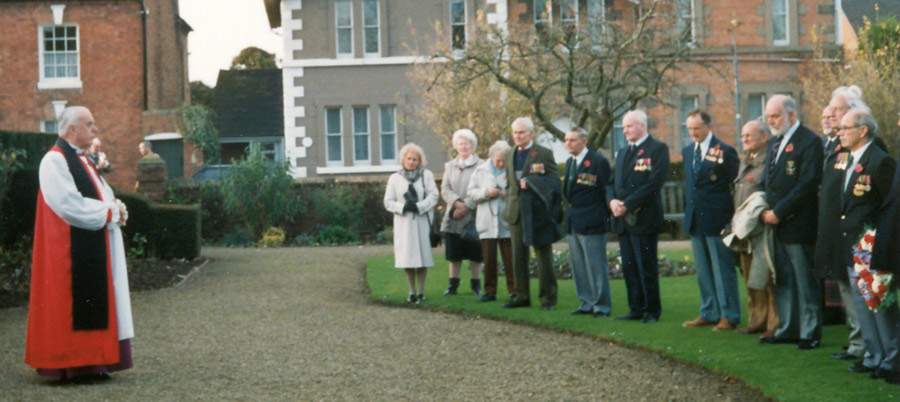The photograph on the back cover of the new edition of
A Hard Fought Ship is of HMS
Venomous
entering the harbour at Casablanca early in the morning of Friday 13
November with her deck crowded with survivors. The painting of HMS
Hecla sinking by Lt
Herbert Hastings McWilliams SANF was based on sketches he made aboard
Venomous
after his rescue on
the back of an old chart with a throat brush and iodene from the sick bay. The finished painting is in the Imperial War
Museum, London, but is not on public display.
Precise figures for the number of men on HMS
Hecla when it was torpedoed off
the coast of Morocco on 11 November 1942, are difficult to ascertain. The
names of 858 men (including 42 officers) are recorded in the Pay and Victualing Ledgers. The
official list of the dead issued by the Admiralty contained the names of 9 men killed and 273 "missing presumed killed". Both lists can be seen on this web site.
Other sources record 799 ratings and 39 officers as being on HMS
Hecla, of which 556 were rescued. HMS
Marne rescued 64 before a torpedo
blew off her stern (see below) but the vast majority, 493, were saved by HMS
Venomous despite having
her
to break off the rescue of survivors to attack the German U-boat. The
stories of many of the survivors - and some of those who died - are
told on this website and in the new edition of
A Hard Fought Ship.
The dramatic events of 11 - 12 November 1942 were described in the new hardback edition of
A Hard Fought Ship: the story of HMS Venomous
published on 9 May 2017 but inow out of print
An e-book edition will be published in 2022
Find out more about the book and see some sample pages
HMS Hecla
Destroyer Depot Ship
Armistice Day has a special significance for the families of the men who died when HMS
Hecla was torpedoed on that long night in 1942. The HMS
Hecla, HMS
Marne and HMS
Venomous
Association organised a dinner at Stratford on Avon on Armistice Day
1992, the fiftieth anniversary, and three of the survivors are still alive today, two in Australia and one near Norwich.
They tell their stories on this website.
In the seven years since the previous edition of
A Hard Fought Ship
was published in April 2010 I was contacted by many more of
the men who lived through that long night and they have shared their
memories with me and I in turn wish to share them with you on this web
site and in the new edition of
A Hard Fought Ship. You can view
a list of all the men in Hecla when she was torpedoed and sank on the night of 11 - 12 November 1942. Please
get in touch if a member of your family served on HMS
Hecla and you have information or photographs for this web site.
Destroyer depot ship at Havelfjord, Iceland, 1941
Hecla was built on the Clyde as a destroyer depot ship and after
being commissioned on the 6 January 1941 was
based at Havelfjord in
Iceland as the mother ship for the destroyers escorting the Atlantic
convoys which kept Britain from starving. Many were elderly V& W
Class destroyers without the range to cross the Atlantic to Nova Scotia
without refueling at Havelfjord and some, like HMS
Venomous, were prone to mechanical failures and spent many days alongside
Hecla
under repair. Other visitors included Winston Churchill on his way back
from signing the Atlantic Charter with Roosevelt and a captured German
U-boat.
Mined off South Africa, 15 May 1942
In the summer of 1941
Hecla was joined by the repair ship USS
Vulcan
and that Autumn returned to the Clyde for a short refit and on 15 April 1942
headed south to an unanounced destination in the southern hemisphere.
She was to have joined the fleet being assembled to defend Singapore
against the Japanese but as described by Capt Law in his RoP
detonated a mine of the coast of South Africa on 15 May and
limped into the naval port of Simonstown where
Hecla spent several months
under repair. These months were a happy interlude for its crew - many
of whom were never to see their homes again.
Five months under repair at Simon's Town in South Africa
During these five months the crew "enjoyed all the advantages of a
peace time visit to a truly beautiful country plus the special welcome
reserved for service men by those South African whites who were on the
whole still sentimental about Britain and Royalty and keen to
demonstrate that loyalty" (
Navy Days; by Ted Coleman).
Many of the crew members were guests of South African families on
"uphomers" and those who survived kept in touch with their hosts for
many years to come. A South African officer, Lt Herbert H. McWilliams
SANF, an architect and talented artist, joined the wardroom and twelve
South African ratings joined the ship. Her new Commanding Officer, Capt
G.V.B. Faulkner RN, was married to a South African and retired to
Cape Town when he left the Navy. The story of these months and the
bonds formed are told in
Hecla: the South African Connection.
Torpedoed off North Africa
On the 20 October
Hecla left Cape Town with Convoy CF.7 for Freetown escorted by HMS
Shropshire. On arrival at Freetown on the 2 November they joined the destroyer depot ship HMS
Vindictive
as part of Convoy CF.7A whch left with a strong escort on the 4
November for Liverpool. A young RNVR rating, Tom Davis, on the
destroyer escort HMS
Active took
the last known photographs of HMS Hecla before she was torpedoed less than a week later.
 The last photograph of HMS Hecla before she was torpedoed and sunk on "The Longest Night"
The last photograph of HMS Hecla before she was torpedoed and sunk on "The Longest Night"
HMS Hecla
left Freetown in west Africa as part of Convoy CF.7A on the 4 November
1942 and was photographed by Tom Davis. the ships writer on HMS Active
Courtesy of Steve Davis, the stepson of Tom Davis
The two destroyer depot ships, HMS
Hecla and
Vindictive, were joined by the destroyer escorts, HMS
Venomous and HMS
Marne,
near the Canaries on the 8 November and detached for Gibraltar to
support the ships taking the troops to the invasion of north Africa,
Operation
Torch. On the night of 11-12 November
Hecla was
torpedoed five times by U-515 commanded by German U-boat ace, Werner Henke. HMS
Marne has its stern blown off while rescuing survivors and HMS
Venomous broke off its rescue efforts to pursue the U-boat.
Venomous
made it it Casablanca, the following morning soon it fell to US trooops
on her last few gallons of fuel, her decks crowded with survivors of
the
Hecla. They were well cared for by the USN and left on the 14 November for Gibraltar,
burying the dead from Hecla at sea enroute.
For a detailed descroption of events on the night of the 11
November 1942 when U-515 penetrated the destroyer escort screen and
topedoed HMS
Hecla five times you should read the new edition of
A Hard Fought Ship: the story of HMS Venomous which was published on 9 May 2017.
Tracking plate showing the position of HMS Hecla, HMS Vindictive, HMS Marne and HMS Venomous during the attack
From: Analysis of U-boat attacks: HMS Hecla, 11-12 November 1942. Report of Anti-submarine Warfare Division (NA Ref: ADM 199/2013)
The names of all
the officers and men on HMS Venomous
during that long night off the coast of Morocco are known and can be
seen on this website in some cases with links to further details of
their memories of what happened.
A Hard Fought Ship describes how HMS
Venomous attacked the U-boat and rescued 500 survivors. It contains photographs taken aboard
Venomous at the time and the vivid paintings of
Hecla sinking by the South African war artist, Lt Herbert H. McWilliams SAN, one of the men rescued.
The View from the Bridge
The officers commanding HMS
Hecla, HMS
Marne and HMS
Venomous and, presumably, HMS
Vindictive,
the other destroyer depot ship being escorted to the invasion beaches
in north Africa were required to write Reports of Proceedings giving
their account of the loss of
Hecla. With the exception of the report by Captain Ackland, the CO of HMS
Vindictive,
these have all been located and with the Report of the ASW Division and
Admiral Cunningham's report on the disaster (sometimes casually
dismissed as "the
Hecla incident") formed the basis for the analysis by Captain John Rodgaard USN in
A Hard Fought Ship.
I have recently been contacted by the son of the Navigation Officer on HMS
Hecla,
Lt Cdr H.C.R. Alexander RN, and sent a typescript of his father's memoir of his time on HMS
Hecla
which describes her loss and is outspoken in its criticism of the
decisions made by Captain H.G.D. Ackland RN, the senior officer of the
convoy. This
is not an official report and may have been written in retirement
though it ends with his own short three point "submission to the
Admiralty". It is the only such document by an officer on
Hecla
known to exist and is a far more vivid account than the somewhat
formalistic RoP of the Commanding Officers of the ships in Convoy but
should be read alongside them if one is to have a balanced view of the
events of that long night off the north African coast. This page also includes
the names of the 42 officers serving on HMS Hecla with links to information about theire lives and service careers.
Rescued by
HMS Venomous
Lt A. d'E.T. Sangster RN, the Gunnery and Correspondence
Officer, who wrote a fifty page memoir of his wartime service in the
Royal Navy in 1981. He joined
Venomous in March 1942 during its refit after its collision with HMS
Keppel and his memoir includes a description of convoy PQ.15 to Murmansk in Northern Russia, the sinking of HMS
Eagle
while flying off hurricanes to relieve the besieged island of Malta and
the events of the night of the 11 - 12 November 1942 when
Hecla sank. He was on watch when HMS
Venomous left its position on the starboard side of the convoy to pursue an Asdic contact and rejoined to find
Hecla dead in the water and
Marne standing by to rescue survivors.
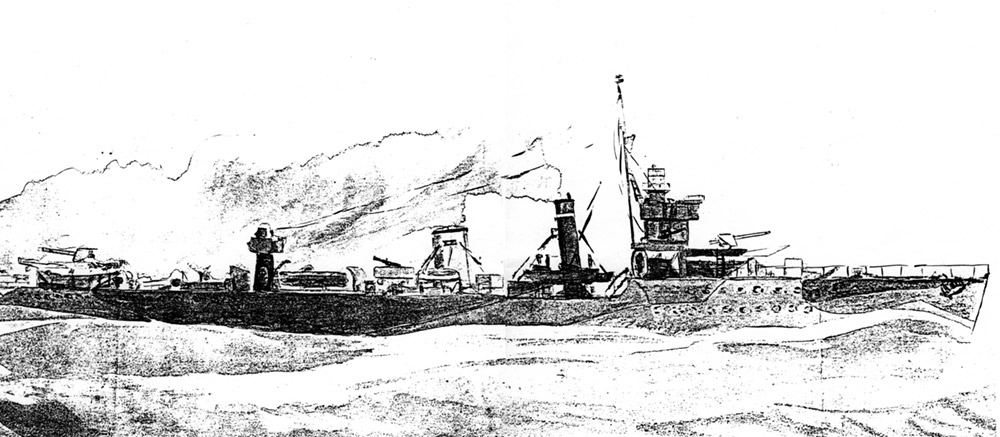 This photocopy of a sketch of HMS Venomous was found amongst the papers of Bob Moore after his death
It is believed to be by Lt H.H. McWilliamsn SANF, the South African architect and artist who drew the dramatic images of HMS Hecla sinking
It was probably done aboard Venomous after his rescue and given to one of her officers
This photocopy of a sketch of HMS Venomous was found amongst the papers of Bob Moore after his death
It is believed to be by Lt H.H. McWilliamsn SANF, the South African architect and artist who drew the dramatic images of HMS Hecla sinking
It was probably done aboard Venomous after his rescue and given to one of her officers
Please get in touch if you can confirm this provisional identification and know its present wherabouts
The performance of Cdr Falcon-Steward and his officers and crew in
fighting the U-boat while rescuing survivors was praised by Admiral
Cunningham in his report but the initial conclusion of the U-Boat
Assessment Committee that the U-Boat had been sunk was subsequently
rejected in its report of the 2 March 1943 (National Archives ADM
199/184) based on two precis of Cdr Falcon Stewards report. Every
member of the crew
played their part in the rescue of survivors, some risking their own
lives by diving in to help the men in the oil covered water. The Anti
Submarine Bosun, Warrant Officer H.J.B. Button RN died later as a
result of his exertions.
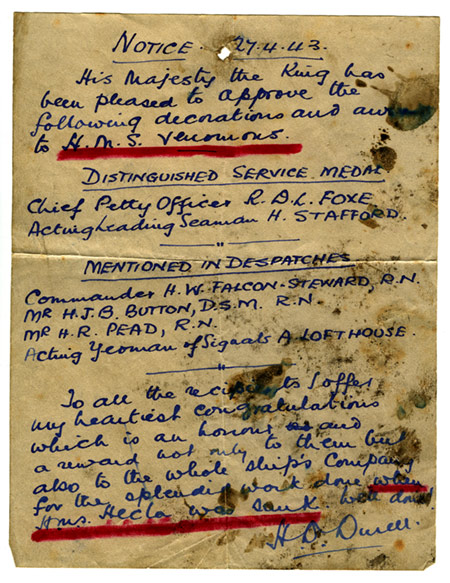
Frederick N.G. Thomas, the RDF Operator on HMS
Venomous when
Hecla sank, had a grandstand view of the action from "the RDF compartment on the highest point of the ship" and wrote
a vivid account of the torpedoing of Hecla,
the pursuit of the attacking U-boat and the rescue of the survivors
during that very long night:
"Radar reported a surface target
dead ahead. Evidently the enemy had surfaced. When the range had closed
sufficiently we fired a star shell. Up went the binoculars on the
bridge. The flare burned brightly, and almost under our bows, it
seemed, was the U-boat, like a monstrous black whale its wet side
glistening in the yellow light.
'Stand by to ram'. Everyone on the bridge held tightly to some firm
object and braced for the shock. The U-boat however, could turn in a
tighter circle and was too quick for us. She was clear with ten yards
to spare, and her guns crew were already training their five-incher on
us. Neither of our four-point-sevens could bear as we reeled to port
under full helm. A quick-witted seaman on our starboard Oerlikon opened
fire and the enemy gun crew melted under the murderous hail. Still
reeling crazily to port, we came round again for another run in and the
U-boat was diving at panic speed. Once again she managed to evade our
cleaving bows, but as we raced by we fired a pattern of depth charges,
one actually striking the submerging conning tower.
Astern the sea shuddered, boiled and upheaved itself into a gigantic
water spout. By the light of our ten inch searchlight we saw a huge,
black cigar shape appear to break slowly into two, both parts slowly
disappearing almost immediately."
"Freddo" Thomas died on the 9 May 2012 aged 92
but his
description of events during that long night can be read in full on this web site.
In April 1943 the new commanding officer of HMS
Venomous, Lt Henry D. Durell RN, was notified of awards made to officers and men on
Venomous
for their conduct during that long night. The note he posted on the
ship's notice board was later kept as a souvenir by Cyril Hely and
presented to Bob Moore when this book was first published. It was
thought to have been lost but has recently been found amongst Bob's
papers which are to be presented to the Royal Navy Museum, Portsmouth,
for safe keeping.
CPO Robert D.L. Foxe (D/J.92864) "was at the wheel throughout" and Acting Leading Seaman
Harold Stafford (D/SSX.14930) was the Asdic operator. Both received the DSM.
Venomous
would never had made it to Casablanca were it not for the imagination
and determination of the Warrant Engineer, Mr Horace Rance Pead RN, who
along with the CO, the Yeoman of Signals Albert Lofthouse (D/JX.135027)
and the Anti-Submarine Boatswain were MID. The bravery of
the Boatswain (A/S), Warrant Officer H.J.B. Button DSM RN, and the
tragic manner in which his life ended is described below. All the men
on
Venomous helped haul the oil covered survivors clinging exhausted to the scrambling nets aboard the destroyer as recalled by
Jack Bolton and
David Hoggins. And some risked their own lives by diving in to pull men to safety.
Warrant Officer H.J.B. Button DSM RN
The unsung hero of that long night was Herbert "Jimmie" Button,
the Anti Submarine Boatswain on HMS
Venomous,
and a strong swimmer. He gave his own life to save the lives of others,
diving in repeatedly to rescue the men struggling for their lives in
the oil covered water, only to die a few days later from his
exertions.
The HMS
Hecla, HMS
Marne and HMS
Venomous Association
were unsuccessful in their
efforts to to trace his family and invite them to their fiftieth
anniversary
dinner on the 11 November 1992 but his
memory was foremost in the minds of many of those present. We now know
that his father
probably died in the trenches before his son was born. He was adopted,
joined the Royal Navy as an Ordinary Seaman, was awarded the DSM and
promoted to officer. He was photographed at the burial at sea of the men who died after
being rescued and was a very popular officer. His story was discovered quite recently and is told here -
click on the link above.
HMS Marne
was torpedoed and nearly lost
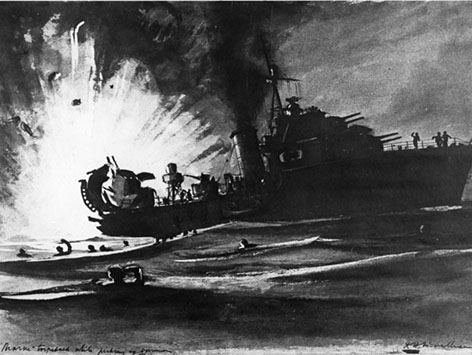
HMS
Marne was a modern M-Class destroyer commissioned in December 1941 which with
Venomous was escorting HMS
Hecla to the invasion beaches at Algeria when
Hecla was torpedoed by U-515.
The CO of HMS Marne
was Lt Cdr H.N.A. Richardson RN
and his Report of Proceedings (National Archives, ADM 1/14272) is one
of the critcal pieces of evidence used to piece together the story of
what happened while
Venomous was away from the convoy following an RFD contact. We also have the vivid description from the
Diary of William Dodds, the Telegraphist on HMS
Marne, sent to me
by his son, Colin Dodds.
Fifty four r
atings and ten officers were rescued by HMS Marne before she was hit in the stern by a torpedo intended for
Hecla (see the sketch at the top of this page) killing fourteen of the crew.
Stan Juson was one of those rescued.
A crew member of Marne was asked by Norman Johns at a Hecla reunion where he was when the torpedo struck Marne in the stern and answered, "I was midships getting your CO and other officers aboard".
Michael Flanders and John Anderson were CW Candidates completing six months service as ratings on
Marne
before being sent for officer training. They had written a light
hearted skit poking fun at their officers which was abandoned when
Hecla was torpedoed. They were ordered into the
ship's whaler to rescue the men in the water
and when
Marne's
stern was blown off they agreed to tell each other's mother should one
of them be killed. Herbert McWilliams was one of those pulled aboard
the
overcrowded whaler. It capsized as it came alongside
Venomous and many of those rescued died despite the bravery of "Jimmie" Button, the Anti-submarine Bosun on
Venomous. The following day
Marne was towed to Gibraltar by HMS
Salvonia escorted by HMS
Jonquil. After commissioning
Lt Michael H. Flanders RNVR served on ML 236 with Coastal Forces and his friend,
Lt John Anderson RNVR, served on the Flower Class corvette, HMS
Saxiflage.
Michael Flanders
(1922-75) was invalided out after contracting poliomyelitis
and went on to achieve fame for his comedy duo with Donald
Swann in "Flanders and Swann". Michael Flanders appeared on
"This is your Life" in 1972.
Above left: Lt Herbert H McWilliams SANF drew this sketch of HMS
Marne being hit in the stern
by a torpedo intended for
Hecla on the back of a signal form after being rescued by HMS
Venomous
The survivors crowd every foot of space on HMS Venomous
(double click the images to see full size) as she enters Casablanca
on the 13 November and leaves for Gibraltar on the 15 November 1942.
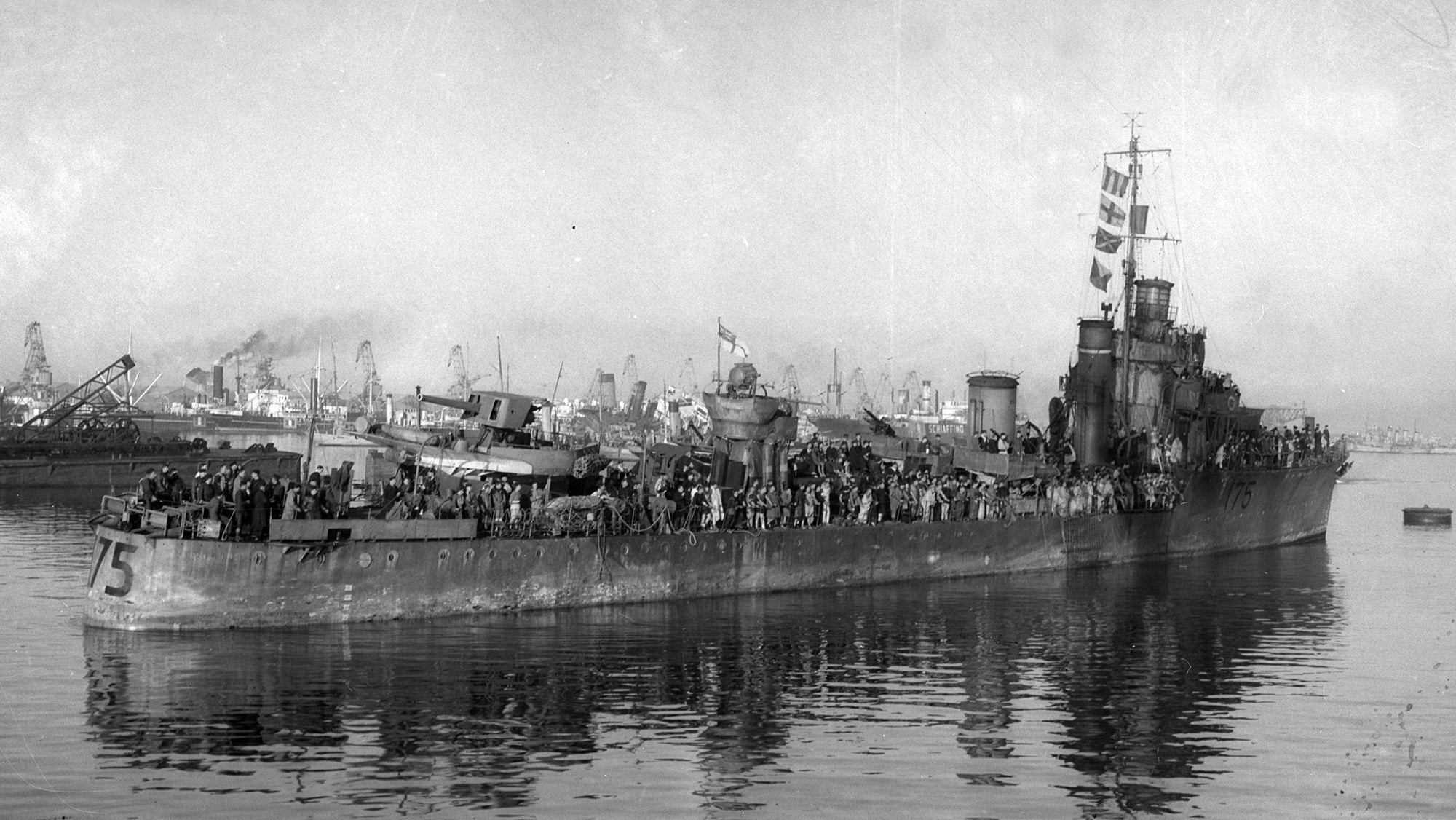
HMS Venomous arriving at Casablanca with her decks crowded with survivors from HMS Hecla
This image appears on the back cover of the hardback edition of A Hard Fought Ship which was published on 9 May 2017
Click on the image twice to view fullsize and zoom in
Ref NARA-080_G-30679
|
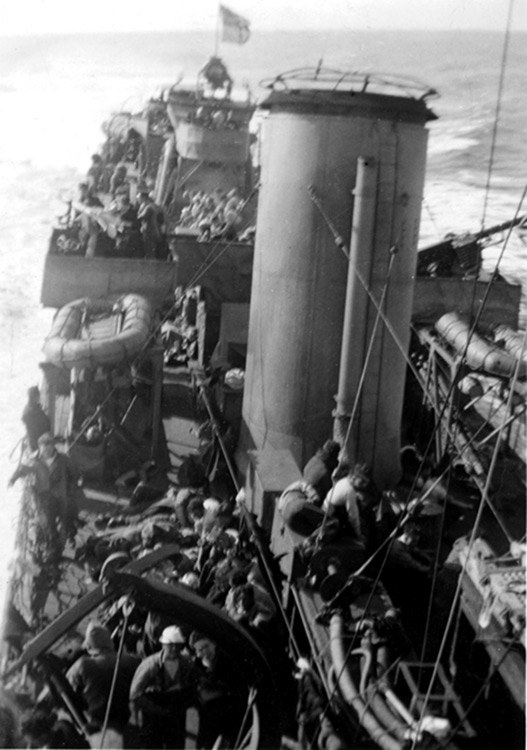
HMS Venomous heading for Gibraltar after leaving Casablanca on 15 November
Click on the image twice to view fullsize and zoom in
View looking astern
Photographed by Mervyn Mansell
|
The stories of the men who served in Hecla
The men who lived and those who died
The
858 names on the crew list
provide an index with live links to their stories but some of the more
interesting are highlighted below. I am still being contacted by
survivors in Australia, Canada,
New Zealand and the UK as well as by the families of many of those who
died on Armistice Day 1942 and their stories are told here by members
of their families. If your family has a story to tell about one of the
men who served om HMS
Hecla do get in touch by emailing me and, if I have your consent, I shall publish it on this website.
"Harry" Alexander, the Navigating Officer on
Hecla, was on the Bridge when the critical decisions were taken
Greg Clark the last surviving officer on HMS
Hecla and first Curator of the RN Museum died aged 95 in August 2012.
Leading Stoker A.R. Cripwell - "Sunk five times but 'Jonah' still smiles"
Harry Cornish and Sam Kingslan, "joined the Navy on the same day and stayed together until the Hecla was torpedoed". Sam, a strong swimmer drowned but Harry was saved by HMS Marne.
Charlie Brierley, a stoker on Hecla, was pulled aboard Venomous by "Jimmie" Button
Stan Juson was one of sixty four survivors including Captain G.V.B. Faulkner RN rescued by HMS Marne
Norman Johns - the last survivor to be rescued formed the HMS Hecla, HMS Marne and HMS Venomous Association in 1990 and was 92 when he died in January 2016.
The stories of the Sick Berth Attendants (SBA) are told first hand or by their families.
Les Proctor - his first ship and nearly his last
Harry Cliffe told the story of his "Navy Days" the year before his death in 2003
Bill Clayton lived to "walk with ghosts on HMS Tyne", an identical sister ship to Hecla.
An AB called 'Charley' helped save the life of Les Mortimer but lost his own
Fred Lemberg - one of twelve ratings from New Zealand on HMS Hecla
You can read more survivors stories on this page and get in touch to tell the story of a member of your family who served in Hecla and survived.
The widows and orphaned children of the 273 men who died that night
had to come to terms with the loss of husbands and fathers. The impact
of their loss continues to be felt up to the present day. David Norman
Holmes Golby has written an account of the life and death of the father
he never knew,
Norman Holmes, Electrical Mechanic 5th Class, on HMS
Hecla. Herbert McWilliams describes seeing his friend
Lt Guy Henry Garrett-Cox RNVR for the last time when he entered the the water after the third torpedo struck. Kenneth Brown
was thirteen when his father,
CPO Norman Brown, died and got to know him better after his death by talking to his shipmates on
Hecla.
Jabez Skelhorne
never returned home to receive his seven year old daughter's Christmas
present and each year it is hung on the family tree at Christmas
and the story retold to his great grandson, Jabez. Christine Donovan
Smith found out about her father,
Don Preece,
a talented and popular cartoonist, by reading the letters he wrote to
his wife after she died.
Their stories are perhaps even more poignant than those of the men who
survived when
Hecla was torpedoed seventy two years ago.
Lt Herbert Hastings McWilliams SANF
This recently commissioned 35 year old officer
in the South African Navy, an architect in his father's practice in
Port Elizabeth before the war, had enlisted as an ordinary seaman in
HMS Shropshire 1941 and joined HMS Hecla at Simonstown after commissioning in the SANF on the 4 September 1942.
He was an exceptionally gifted artist and his wonderfully
realistic paintings of
Hecla sinking on the back of old charts (based on sketches done with a throat brush and a mixture of iodine and rum
from the sick
bay of
Venomous) and extracts from his description of that night taken from a
letter to his Mother written within days of its loss are included in
A Hard Fought Ship.
These paintings are in the Imperial War Museum, London.
Do you have a story to tell?

Anniversaries of the sinking of HMS Hecla
The men who were there when HMS Hecla was torpedoed and sank off the north African coast on the 11 - 12 November 1942 formed the "HMS Hecla, HMS Marne and HMS Venomous
Association" which organised a
reunion at Stratford on Avon on the
fiftieth anniversary of its loss in 1992.
There were too few men alive in 2017 to celebrate the 75th anniversary of the loss of HMS Hecla but their stories told by their families on this website and in Chapter 13, The Longest Day, of A Hard Fought Ship: the Story of HMS Venomous.
Wreath laying ceremony at the War Memorial in Stratford on the fiftieth anniversary in 1992
Some members told their own stories
and Norman
Johns, the Secretary of the Association, put me in touch with others
who recalled their memories of that long night. The lengthy chapter in A Hard Fought Ship
weaves together their stories with the facts given in the reports of
proceedings written by the commanding officers and the memories of the
officers and men of HMS Venomous.
Finally, take a look at the Hecla Scrapbook - can you throw some light on the items posted here?
A list of the 858 men recorded in the Pay and Victualing Ledgers as being on HMS Hecla on the night it sank with links to further details
The official Admiralty List of those who died when HMS Hecla sank can also be downloaded as a PDF
It contains the full name, rank, rate and service number of all those who died and those "missing presumed killed"
Find out how to obtain the service record for a family member who served on HMS Hecla
The story of HMS Venomous is told by Bob Moore and Captain John Rodgaard USN (Ret) in
A Hard Fought Ship
A Hard Fought Ship contains the most detailed account of the loss of HMS Hecla yet published
Take a look at the Contents Page and List of Illustrations
"The ship’s role in the events surrounding the loss of the depot ship Hecla and crippling of the destroyer Marne
at the hands of Germany’s U-515 ... is especially well documented.
Rigorous design and production values means that images are reproduced
clearly to a high standard, and the overall book has a quality
feel."
"Naval Books of the Year, 2012" - Warship.








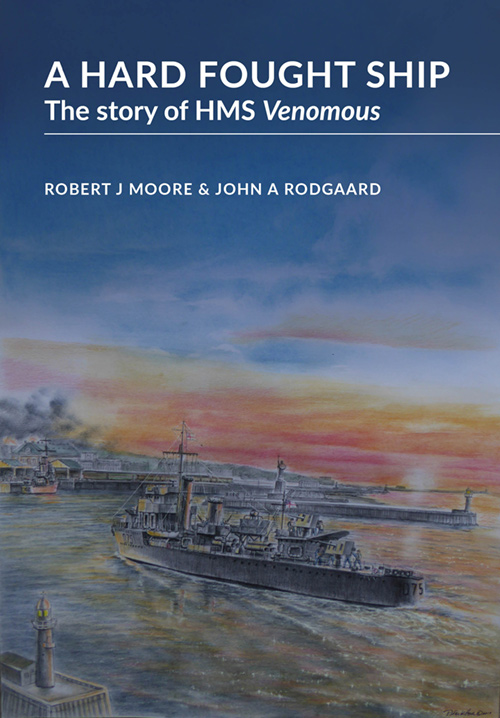
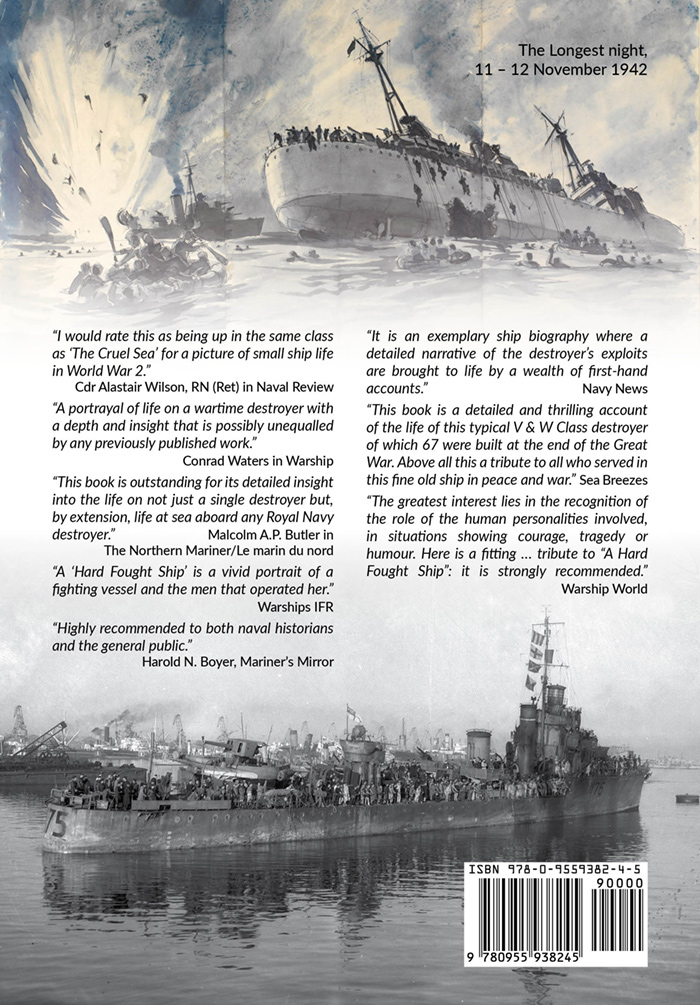

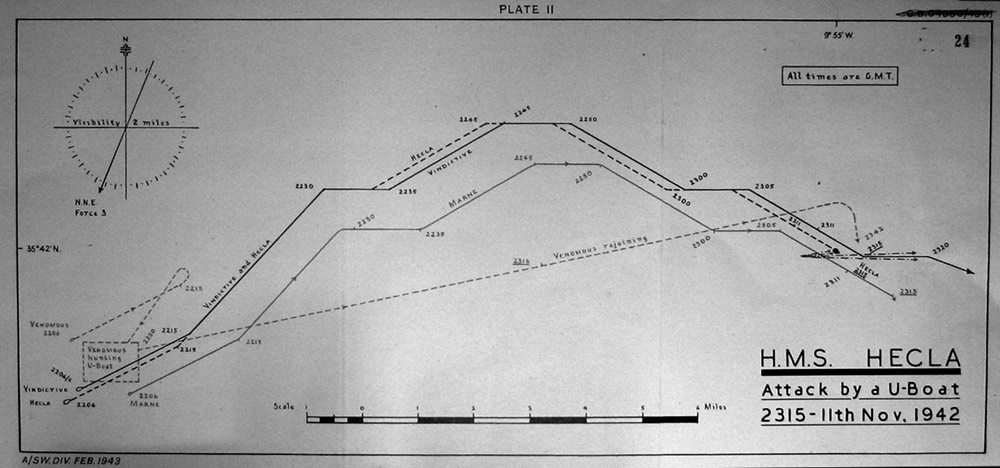


 HMS Marne was a modern M-Class destroyer commissioned in December 1941 which with Venomous was escorting HMS Hecla to the invasion beaches at Algeria when Hecla was torpedoed by U-515. The CO of HMS Marne
was Lt Cdr H.N.A. Richardson RN
and his Report of Proceedings (National Archives, ADM 1/14272) is one
of the critcal pieces of evidence used to piece together the story of
what happened while Venomous was away from the convoy following an RFD contact. We also have the vivid description from the Diary of William Dodds, the Telegraphist on HMS Marne, sent to me
by his son, Colin Dodds.
HMS Marne was a modern M-Class destroyer commissioned in December 1941 which with Venomous was escorting HMS Hecla to the invasion beaches at Algeria when Hecla was torpedoed by U-515. The CO of HMS Marne
was Lt Cdr H.N.A. Richardson RN
and his Report of Proceedings (National Archives, ADM 1/14272) is one
of the critcal pieces of evidence used to piece together the story of
what happened while Venomous was away from the convoy following an RFD contact. We also have the vivid description from the Diary of William Dodds, the Telegraphist on HMS Marne, sent to me
by his son, Colin Dodds.


